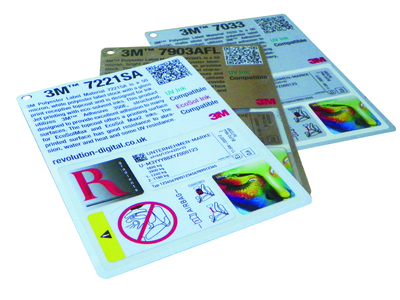A marriage of software, hardware and specially-developed self-adhesive label material has solved a recurring label sector conundrum: the cost effective production of full colour short run variable data labels that are durable without lamination.
The Roland DG-authorised reseller revolution-digital.co.uk in Coalville, Leicestershire, has a heritage in selling screen printed t-shirts, and it first started using digital printing systems such as Epsons and Canons for producing screen printing separations. Today though, it is looking to make waves in the digital labels sector.
It began working with Roland DG following Ipex 2010, and subsequent to that, it started doing some testing with materials manufacturer 3M, which was trying to specify a label material that could be used in the automotive industry, with all the stickers for a single car being digitally printed on a single wide format sheet. Revolution spent six to eight months working with polyester and PVC products to produce durable labels without the need for lamination, which could be printed on Roland’s UV and solvent-based print & cut systems.
To cut a long story short, the testing and development was successful, resulting in a range of self-adhesive labels materials that can be used across these devices, including a unique 50 micron white polyester label stock, with 3M’s special 350E acrylic adhesive, which has a structured liner that helps users to apply the labels bubble free, and makes it suitable for application to most surfaces. This polyester film can be printed using Roland EcoSolMax and EcoSolMax2 solvent inks, or any Roland UV printer. And this, said managing director Jan Edgecombe, ‘turns every sign printer into a label printer’.
The next part of the solution has involved barcode and labelling software developer NiceLabel, whose Designer Pro software and database capabilities have been integrated with Roland DG’s VersaWorks RIP software to create a simple yet powerful variable data label output solution. Using this software link, labels with variable data, including individual serial numbers, bar codes, QR codes, and even images, can be created from several data sources and types of database. These individual labels appear in the VersaWorks RIP with, and here is the clever bit, a cutting path already assigned, so users need only press print and the Roland printer/cutter will do the rest.

The result is a high-quality variable data label that gives users the option to print colour and black variable data, and to cut the labels all on the same printer, making it ideal for micro to short-run applications.
Mr Edgecombe explained the predicament currently faced by those needing variable data labels: ‘If you want to put a serial number on every product, you can talk to someone with a thermal ribbon printer and they can print it, but it won’t necessarily be durable without lamination, and you certainly cannot cut out any shape you like. Roland can do that in full colour but with VersaWorks it’s not easy to put a serial number on. NiceLabel allows you to take a database of orders generated off a mainframe; it can suck data from two or three different sources and put them on one label. It is very sophisticated yet easy to use. And with these 3M products you get durable labels with fantastic adhesive that can be printed on a wide format printer.’
The current version of this software link allows printing variable data onto the white polyester label material mentioned above (code number 3M 7221SA). The next version, which is due to be available by the end of the year, will include special colours and varnish, which will enable a number of applications using a bright silver polyester label stock (which also uses the 350E adhesive) that has also been developed with 3M (code number 7903AFL).
With the prospective introduction in June 2015 of GHS legislation – the Globally Harmonised System of Classification & Labelling Chemicals – which will mean that labels must be able to resist the chemicals within the container they are placed upon, the requirement for durable labels is sure to increase; variable data capability is also of growing importance. A solution such as Revolution’s Roland DG/NiceLabel/3M package is therefore well-timed.
Mr Edgecombe added: ‘We have got traditional flexo guys using it, picking up a lot of short run, high margin work that they would normally turn away. Lots of people will get Adobe Illustrator, draw a label as an individual piece of artwork, and keep generating it with variable data. This is much easier: you draw one label and generate many.’





